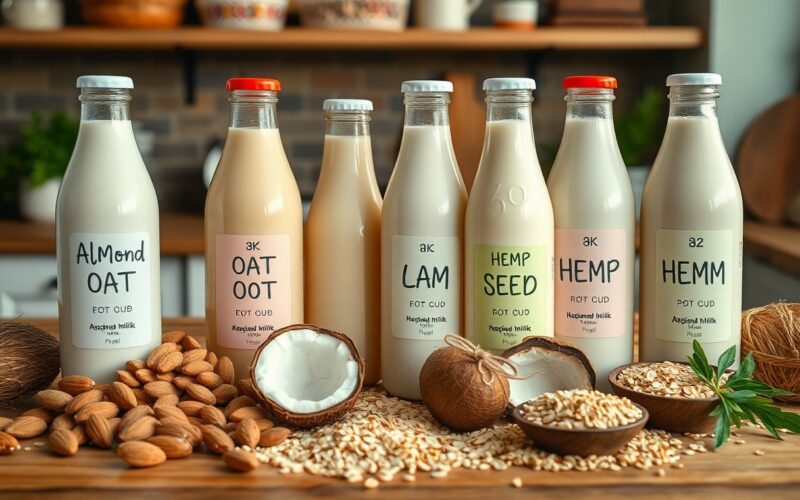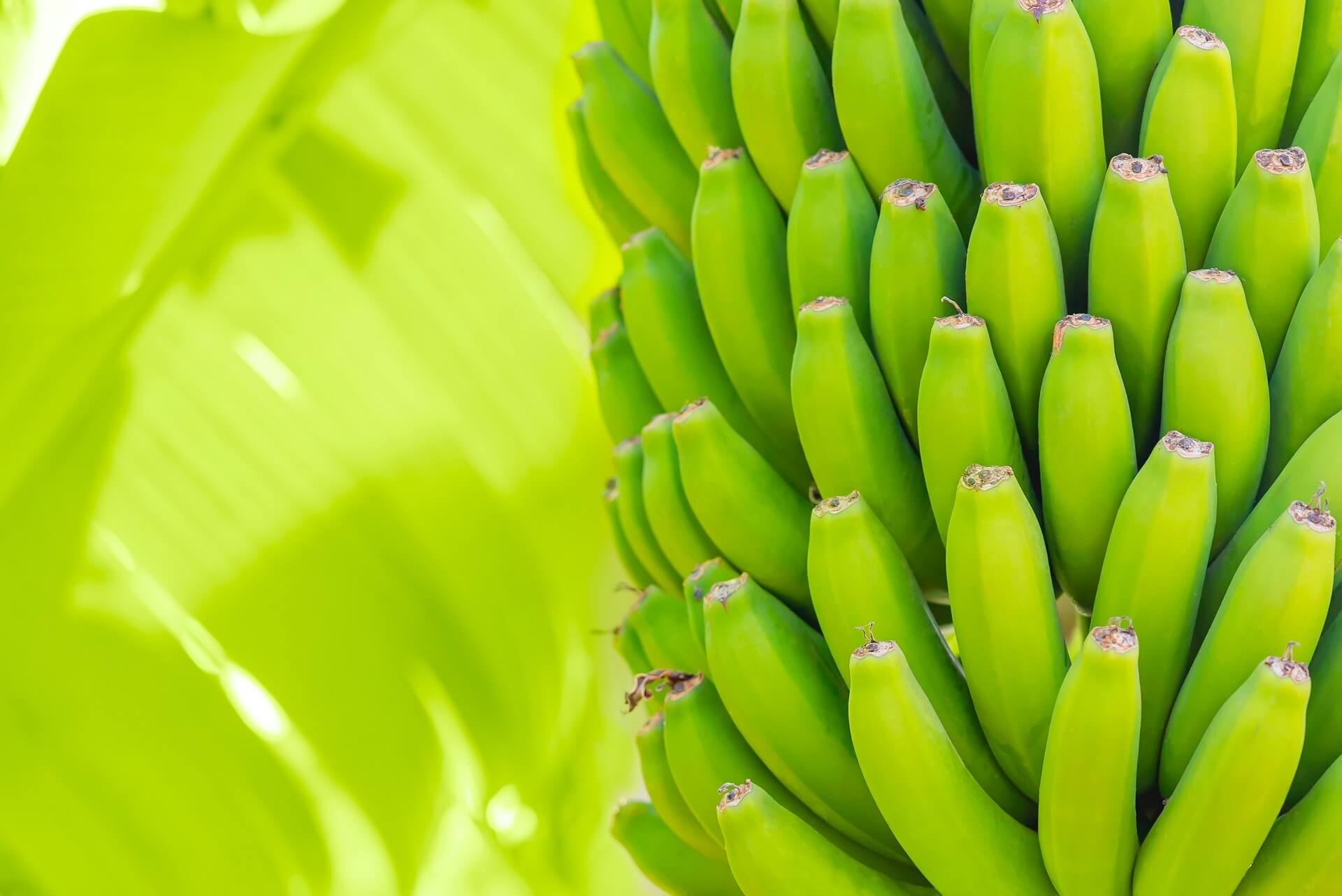Most people are exploring milk alternatives for various reasons, from dietary restrictions to ethical considerations. In this listicle, you will discover the top 10 healthiest milk alternatives, each with unique health benefits and versatile uses in your kitchen. Whether you’re looking to reduce dairy consumption, increase nutrient intake, or simply try something new, these options can enhance your meals and beverages. Join us as we probe into the flavorful world of milk alternatives and teach you how to incorporate them into your daily routine.
Table of Contents
Key Takeaways:
- Almond milk is low in calories and enhances dishes with its nutty flavor, making it a great choice for smoothies and cereals.
- Oat milk is creamy and naturally sweet, ideal for coffee drinks and baking due to its ability to froth well.
- Coconut milk offers a rich taste and is excellent in curries and desserts, providing a distinct tropical flavor.
- Soy milk is high in protein, making it a popular substitute for those looking for a more nutrient-dense option in protein shakes and cooking.
- Cashew milk is smooth and versatile, suitable for creamy soups and sauces, adding a rich texture without overpowering other flavors.
Almond Milk
While searching for a delicious and healthy milk alternative, almond milk stands out due to its light flavor and creamy texture. Made from blended almonds and water, this plant-based option is low in calories and fortified with important vitamins and minerals such as calcium and vitamin D. It’s an excellent choice for people who are lactose intolerant or looking to reduce their dairy intake, providing a versatile base for various dishes without compromising on taste or nutrition.
Smoothies
Now, when it comes to crafting smoothies, almond milk serves as an outstanding base that enhances both flavor and nutrition. You can mix it with your favorite fruits like bananas, berries, or spinach to create a smooth, creamy texture that’s satisfying and full of important nutrients. The subtle nutty flavor of the almond milk complements a range of ingredients, making it a perfect addition whether you aim for a tropical or green smoothie.
Cereal
Any time you enjoy a bowl of cereal, consider switching from traditional dairy milk to almond milk for a lighter option that pairs wonderfully with most cereals. This substitution works particularly well with whole grain or nut-based cereals, enhancing the overall flavor while adding a dose of healthy fats and protein. With its naturally sweet taste, almond milk can enhance your breakfast experience, offering a delightful alternative that keeps you feeling satisfied.
To make the most of almond milk in your cereal, simply pour it over your favorite flakes, clusters, or granola and watch the flavors meld together. You might find that not only does it elevate the taste, but it also supports better digestion. Plus, the low calorie count means you can enjoy your breakfast without worrying about unwanted calories, making your mornings both enjoyable and health-conscious.
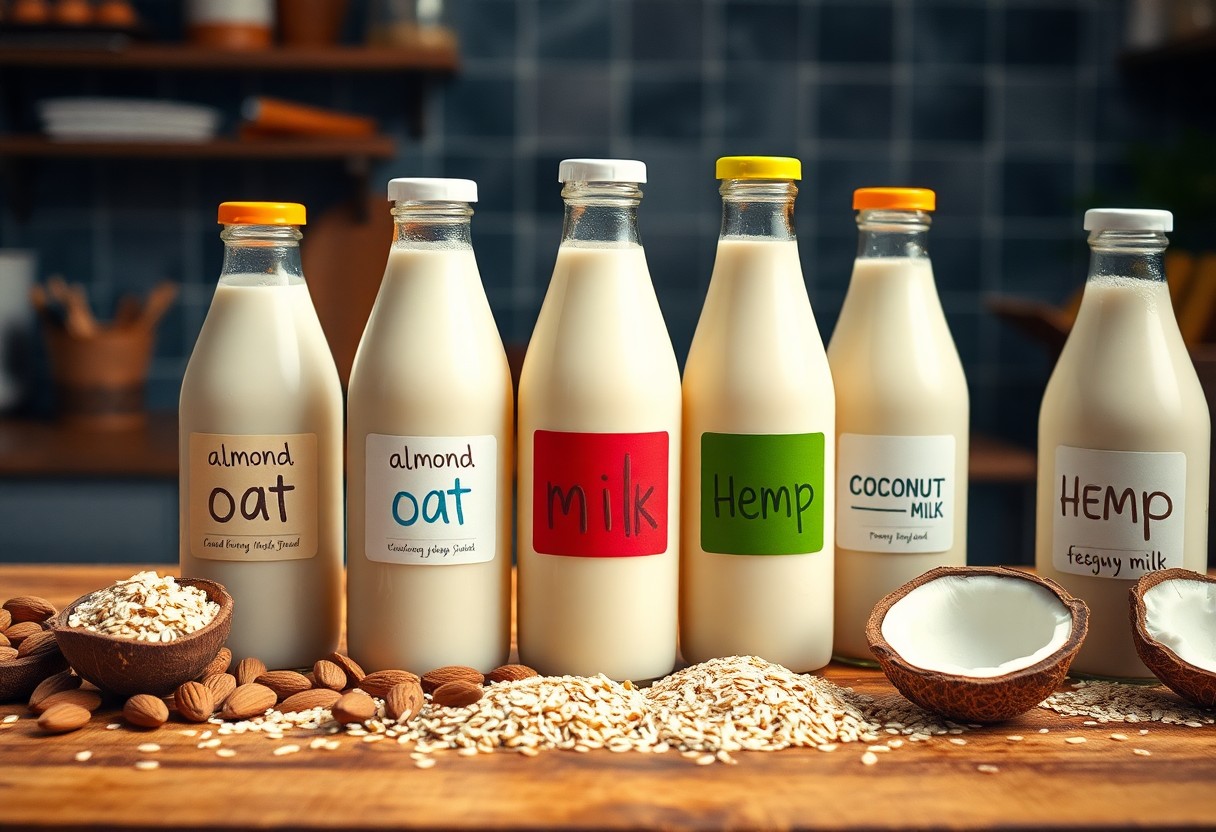
Soy Milk
Even though it contains fewer calories than whole milk, soy milk is a powerhouse option for those looking for a nutritious milk alternative. It’s packed with vital amino acids, making it an excellent protein source for vegans and vegetarians. As noted in 11 Healthiest Milks, Ranked by a Dietitian, soy milk is also naturally low in saturated fat and cholesterol-free. Additionally, it often comes fortified with vitamins and minerals like calcium, Vitamin D, and Vitamin B12, which are beneficial for bone health and overall well-being. This makes soy milk an ideal choice for anyone looking to optimize their dietary intake.
Cooking
On the cooking front, soy milk stands out as a versatile substitute for traditional dairy milk. You can confidently use it in savory recipes, such as soups, sauces, and pasta dishes, without sacrificing flavor or texture. Its creamy consistency means it blends well into dishes, adding richness while still being a plant-based option. Just keep in mind that if you’re making something delicate, like a custard or white sauce, it’s best to use unsweetened soy milk to maintain the intended taste and consistency.
Baking
On the baking side of things, soy milk can seamlessly replace cow’s milk in many recipes, from pancakes to cakes. The key here is to choose unsweetened soy milk to avoid overly sweet results. Since soy milk has a slightly nutty flavor, it can enhance the overall taste of your baked goods, giving them a unique twist. Always remember to adjust the baking time slightly, as soy milk may alter the moisture content in your creations.
Plus, soy milk works wonderfully in recipes that require creaminess, such as muffins and brownies. By substituting soy milk for dairy, you not only cater to lactose intolerance or vegan diets but also promote a more health-conscious lifestyle. Just be cautious if you’re baking something very delicate, as the protein in soy milk behaves differently than animal milk; make sure to monitor your baked goods closely for ideal results.
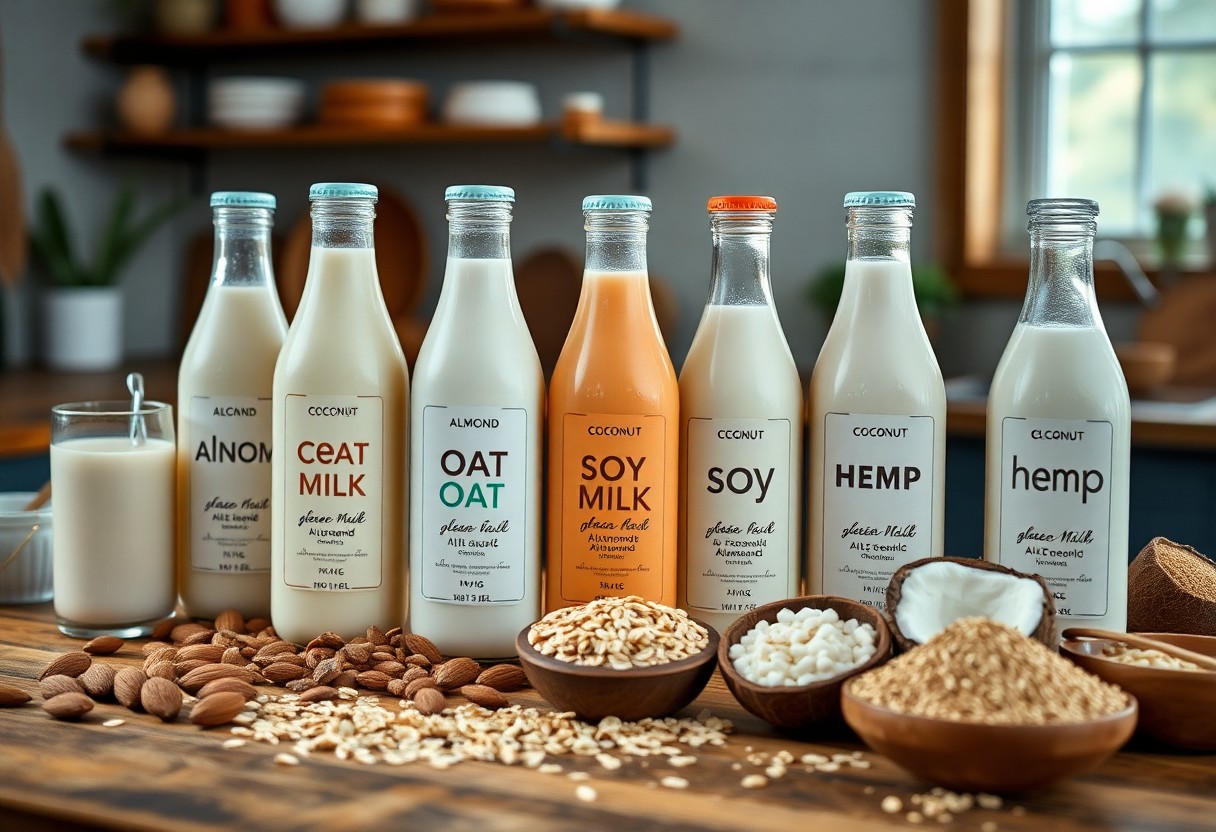
Oat Milk
All dairy alternatives have been gaining popularity in recent years, and oat milk stands out for its creamy texture and naturally sweet flavor. Derived from whole oats, this plant-based milk is not only dairy-free but also offers a variety of health benefits that may support your overall well-being. It is typically lower in calories and fats compared to cow’s milk and is a good source of vitamins and minerals such as vitamin D, calcium, and fiber. If you’re lactose intolerant or simply seeking a healthier option, oat milk is an excellent choice that can be incorporated into various recipes.
Coffee
The inclusion of oat milk in your coffee can transform your morning routine. This milk alternative froths beautifully, making it perfect for lattes and cappuccinos. When you pour it into your afternoon brew, you’ll notice how its creaminess helps balance out the acidity of the coffee, enhancing its overall flavor profile. Additionally, many people appreciate its naturally sweet taste, reducing the need for added sugars or syrups, allowing you to enjoy a healthier cup of coffee.
Creamy sauces
Coffee lovers aren’t the only ones who can benefit from the versatility of oat milk; it shines in creamy sauces as well. Oat milk adds a delightful creaminess without the heaviness of traditional dairy cream, making it an excellent base for sauces used in pasta or as a complement for roasted vegetables. Your dishes will taste rich and decadent, but with fewer calories, allowing you to indulge without guilt.
With its ability to create a smooth consistency, oat milk serves as a wonderful alternative for your favorite creamy sauces. You can seamlessly substitute oat milk in recipes that call for heavy cream, giving you a lighter option while still achieving that delicious creaminess you desire. By incorporating oat milk, not only do you enhance the flavors of your dish, but you also add a splash of goodness, supporting your dietary choices without compromising on taste.
Coconut Milk
To explore the creamy richness of coconut milk is to investigate a world of versatile culinary applications. This dairy-free alternative is made from the meat of mature coconuts and provides a wonderful source of healthy fats, particularly medium-chain triglycerides (MCTs), that support energy and metabolism. When seeking a plant-based milk that can satiate your cravings, coconut milk stands out as both a nutritious and delicious option, perfect for those who avoid dairy or simply want to try something new.
Curries
Clearly, when it comes to enhancing the flavor profile of your curries, coconut milk is an unbeatable choice. It not only adds a unique richness but also balances out spices with its natural sweetness. Whether you’re whipping up a classic Thai red curry or opting for a spicy coconut curry chicken, incorporating coconut milk can elevate your dish to restaurant-quality levels. Additionally, it provides the creaminess necessary to achieve a smooth and delectable sauce that clings beautifully to vegetables and proteins.
Desserts
On top of curries, coconut milk shines equally in desserts. You can use it to create luscious puddings, smoothies, and even ice creams, providing a delightful alternative to traditional dairy products. The natural sweetness of coconut milk pairs beautifully with ingredients like chocolate, vanilla, and fruit, allowing you to enjoy satisfying and wholesome treats. Plus, if you are seeking a vegan dessert option, coconut milk can be your secret weapon to crafting dishes that are both indulgent and health-conscious.
With its creamy consistency and enticing flavor, coconut milk can elevate a variety of dessert recipes. For instance, you might try using it in coconut panna cotta for a velvety texture or drizzling it over tropical fruit salads to enhance their freshness. Its ability to blend seamlessly with sweet flavors makes it an excellent base for baking, especially in cakes and muffins where you would normally use milk. By experimenting with coconut milk in your desserts, you can enjoy the benefits of healthy fats while savoring delicious and creative ways to satisfy your sweet tooth.
Rice Milk
Many people are turning to rice milk as a suitable alternative to dairy, especially those with nut allergies or lactose intolerance. Made primarily from brown or white rice and water, rice milk has a naturally sweet flavor, and it is often fortified with vitamins and minerals to enhance its nutritional profile. This milk substitute is low in fat and protein compared to other alternatives, making it a light, easy option for those looking to reduce their calorie intake. How you incorporate rice milk into your diet can make a big difference in its nutritional benefits, and it can easily fit into both sweet and savory recipes.
Soups
You can elevate your soups with rice milk, which enhances a creamy texture without overpowering the original flavors. For instance, when making a classic potato leek soup or a vegetable chowder, simply replace the traditional cream or cow’s milk with rice milk. Not only does this add a delightful component to your soup, but it also provides an easily digestible alternative, making it a favorite among those seeking lighter options. The subtle sweetness of rice milk pairs well with herbs and spices, allowing you to create a cozy bowl of goodness without added fats or heavy ingredients.
Sauces
On the subject of sauces, rice milk can be a fantastic base for creamy dressings or gravies. When preparing a simple white sauce for pasta, substitute regular milk with rice milk, and you’ll find it complements flavors beautifully while maintaining a smooth consistency. This technique is also great for people on specific dietary regimens since rice milk is free from common allergens.
Plus, rice milk works exceptionally well in vegan sauces or dishes where a lighter touch is desired. By mixing it with herbs, garlic, or even nutritional yeast, you can craft a delightful sauce that’s perfect for drizzling over roasted vegetables or pasta. The key to using rice milk in sauces is balancing flavors; you might want to enhance the taste with seasonings like salt or lemon juice to achieve the perfect blend and make your meal truly irresistible.
Hemp Milk
Your quest for a nutritious milk alternative can lead you to the benefits of hemp milk. Made from the seeds of the hemp plant, this creamy beverage is not only rich in healthy fats but also boasts a profile of crucial vitamins and minerals. Packed with omega-3 and omega-6 fatty acids, hemp milk can support your heart health while providing a slight nutty flavor that enhances smoothies, cereals, and coffee. As you explore options, you might find it helpful to check out The 7 Healthiest Milks, According to a Dietitian for further insights.
Protein Shakes
There’s a great opportunity to include hemp milk in your protein shakes. By blending this plant-based milk with protein powder, fruits, or greens, you create a nutritionally balanced drink that can support recovery and muscle growth. Hemp milk contains about three grams of protein per cup, making it a decent option to complement your workout routine. With its creamy texture, you’ll enjoy a smooth shake without overpowering the flavors of your other ingredients.
Sauces
There’s an exciting way to incorporate hemp milk into your cooking—through sauces. Using hemp milk as a base for creamy sauces can add a distinct flavor while keeping your mealsPlant-based and wholesome. It’s versatile enough for everything from savory pasta sauces to rich dressings. You can experiment by substituting traditional dairy milk with hemp milk in recipes, offering a nutty twist that elevates your dishes.
Any time you use hemp milk in your sauces, you’re not only enriching the dish with its unique flavor but also enhancing its nutritional profile. Just keep in mind that while hemp milk can elevate your culinary creations, it is typically lower in protein compared to cow’s milk. Hence, adjusting the balance of your ingredients can help you achieve desired results. This milk alternative delivers a delightful taste while serving as a fantastic dairy replacement.
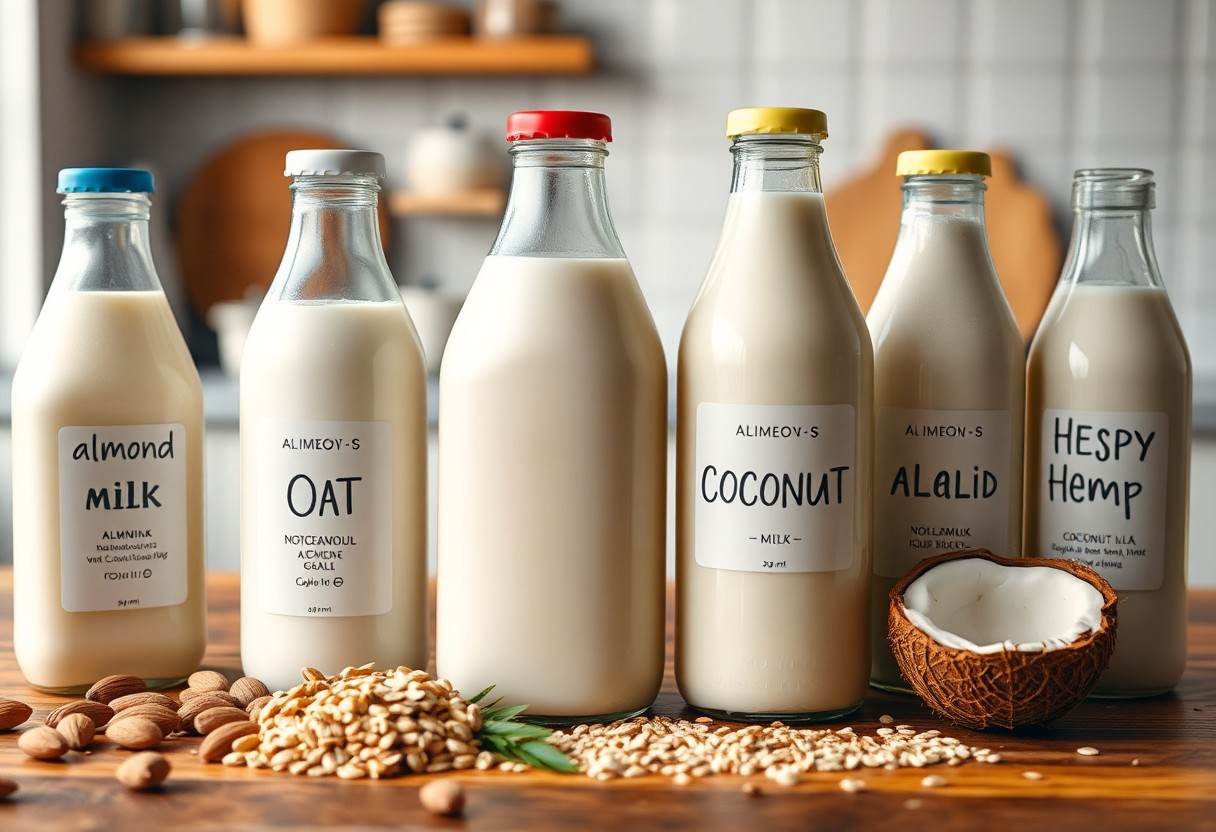
Cashew Milk
Once again, you are introduced to a delightful option—cashew milk. This creamy alternative is not only delicious but also offers a range of health benefits that can enhance your diet. According to a piece on Healthiest Milk: 9 Dairy and Plant-Based Options, cashew milk is low in calories and contains healthy fats, making it a great choice for those looking to reduce their overall calorie intake while still enjoying a rich texture in their beverages and recipes.
Creamy Soups
Little do many know, cashew milk can be a fantastic base for creamy soups. Its naturally rich and smooth consistency transforms simple vegetable soups into indulgent bowls of comfort. To create a creamy soup, try blending your favorite vegetables with cashew milk and spices for an irresistible dish. This plant-based alternative not only enhances flavor but also adds a nutritious touch, making it a perfect choice for your next meal.
Sweets
While indulging your sweet tooth, consider using cashew milk for dessert recipes. This alternative pairs beautifully with various sweet ingredients, such as vanilla or cocoa, to create a delightful creamy texture in puddings, cakes, and ice creams. Not only does it add rich flavor, but it also packs a nutritional punch without the lactose found in cow’s milk. Cashew milk can seamlessly replace dairy in recipes, making your desserts healthier yet equally satisfying.
Milk from cashews does more than just add creaminess; it also introduces a nutty flavor that can elevate your cooking. Whether you’re whipping up cookies, cakes, or any other sweets, substituting dairy with cashew milk can enhance the overall nutrient profile of your treats while still maintaining a luscious texture. So, as you explore the world of dairy alternatives, give cashew milk a try to create delicious and health-conscious sweet dishes.
Pea Milk
Unlike traditional dairy milk, pea milk is made from yellow split peas, making it a fantastic plant-based alternative that’s not only environmentally friendly but also highly nutritious. It contains a good amount of protein, necessary amino acids, and is often enriched with vitamins and minerals. Due to its creamy texture and neutral flavor, pea milk serves as an excellent substitute for nearly any recipe that calls for milk, providing you with a source of nourishment without the lactose or allergens that come with cow’s milk.
Smoothies
On your journey to a healthier lifestyle, incorporating pea milk into your smoothies is a seamless way to increase your protein intake without sacrificing taste. The creamy and smooth consistency of pea milk helps blend beautifully with fruits, vegetables, and other smoothie ingredients, adding a delightful richness. Whether you enjoy a berry smoothie or a green concoction loaded with spinach, you will find that pea milk complements the flavors while giving your drink an additional nutritional boost.
Protein-rich recipes
With its impressive protein content, pea milk is an excellent choice for those looking to create protein-rich recipes that can fuel your day. Adding it to overnight oats, soups, or pancakes elevates your meals while providing necessary nutrients your body needs. You can use pea milk as a base for sauces or cream soups, delivering the same creamy texture as traditional dairy without any of the dairy-related concerns.
Plus, you can experiment with various flavors by mixing pea milk in your baked goods or savory dishes. For instance, using pea milk in protein-packed smoothies is a great way to start your day energized, while incorporating it into a creamy risotto or mac and cheese can provide that comforting feel you crave without the added cholesterol. Whether you’re aiming to build muscle or just maintain a balanced diet, pea milk enriches your meals and snacks with the nutrition you deserve.
Flax Milk
After exploring the various benefits of milk alternatives, you may find that flax milk stands out as an especially nutritious option. Derived from ground flaxseeds and water, this non-dairy milk is naturally low in calories and free from common allergens like lactose, soy, and nuts. Rich in omega-3 fatty acids, flax milk can help support heart health and may even promote healthy skin. Additionally, it contains lignans, a type of antioxidant that can further enhance your overall well-being. With its mild flavor, flax milk can easily be integrated into your daily diet, making it a versatile and healthful choice.
Cereal
There’s nothing quite like a bowl of cereal to kick-start your day, and using flax milk can elevate both the flavor and health benefits of this breakfast staple. When you pour flax milk over your favorite cereal, you’ll not only enjoy a delightful creamy texture but also add a dose of nutritional value that traditional dairy milk may lack. The subtle nutty flavor of flax milk complements various cereals, whether you choose a crunchy granola or a sweetened option.
Baking
Now that you’ve discovered how to use flax milk in cereal, consider incorporating it into your baking recipes. Flax milk can replace dairy milk in most baking scenarios, allowing you to enjoy your favorite cakes, muffins, and breads without compromising on moisture or flavor. You’ll find that flax milk provides a similar consistency to dairy milk, so your baked goods will turn out just as delicious, while reaping the benefits of excellent health properties.
Any time you choose to bake with flax milk, it’s vital to note that this milk alternative is surprisingly versatile. You can easily swap equal parts of flax milk for regular milk in recipes for pancakes, brownies, or even homemade pizza dough. Just be cautious with recipes that rely heavily on the structure provided by dairy; you might need to adjust the liquid ratios slightly for the best results. Overall, using flax milk in your baking endeavors allows you to indulge in sweet and savory treats while making a healthier choice.
Final Words
On the whole, exploring the top 10 healthiest milk alternatives offers you a variety of options to enhance your dietary choices while meeting your personal health goals. Each alternative presents unique benefits, whether it’s the high protein content of soy milk or the creaminess of oat milk. By understanding how to incorporate these alternatives into your daily routine—be it in smoothies, coffee, or cooking—you can easily enrich your meals and enjoy the diverse flavors they bring to your palate.
Moreover, considering your dietary restrictions or preferences can guide you in selecting the right milk alternative for your lifestyle. Plant-based options are not only beneficial for your health but also for the environment. As you experiment with these alternatives, pay attention to how your body responds and stay informed about nutritional values to make the best choices for you and your family. Embrace the journey of discovering healthier alternatives, and enjoy the positive impact it can have on your overall well-being.
FAQ
Q: What are the top 10 healthiest milk alternatives?
A: The top 10 healthiest milk alternatives include almond milk, soy milk, oat milk, coconut milk, rice milk, hemp milk, cashew milk, flax milk, pea milk, and macadamia milk. Each type offers unique nutritional benefits and flavors, making them suitable for various dietary needs and preferences.
Q: How do I choose the best milk alternative for my diet?
A: Choosing the best milk alternative depends on your dietary needs, taste preferences, and any allergies. For protein content, soy milk and pea milk are excellent choices. If you seek a low-calorie alternative, almond or coconut milk may suit you best. It’s also important to look for options that are fortified with vitamins and minerals like calcium and vitamin D.
Q: Can I use milk alternatives in baking and cooking, like cow’s milk?
A: Yes, most milk alternatives can be used in baking and cooking. However, the flavor and texture may vary. For example, coconut milk will add a distinct coconut flavor, while oat milk can add slight sweetness. It’s advisable to choose a substitute that complements the dish you’re preparing.
Q: Are there any nutrients that I might be missing out on by switching to milk alternatives?
A: Cow’s milk is a rich source of calcium and vitamin B12, which are sometimes lower in plant-based milk alternatives. However, many brands fortify their milk alternatives with calcium, vitamin D, and other nutrients, so it’s imperative to check the labels. Incorporating a variety of fortified foods into your diet can help ensure adequate nutrient intake.
Q: Which milk alternative is the most sustainable choice?
A: Oat milk is often considered one of the most sustainable milk alternatives due to its lower water usage and carbon footprint compared to other options. Almond milk, while popular, requires significant water to produce. Additionally, soy milk is eco-friendly but comes with considerations regarding land use for soy cultivation. Choosing locally sourced or organic options can further enhance sustainability.

Our contributing author is a passionate advocate for eco-friendly living and sustainability. With a background in eco-life, they are dedicated to inspiring and empowering individuals to adopt environmentally conscious lifestyles. Through insightful articles, they share practical tips, innovative solutions, and thought-provoking perspectives to promote a greener, more sustainable world. Join them on the journey towards eco-smart living and discover how small choices can make a big impact. 🌱

